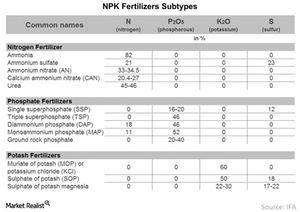The Most Common NPK Fertilizers: Why Combinations Are Important
Fertilizers are commonly labeled using a convention that includes the amount of NPK available in the mix.
Jan. 13 2017, Published 8:17 a.m. ET

Fertilizer types
Previously, we saw that nitrogen, phosphorous, and potassium (or NPK) are the top three macronutrients used in agriculture. But there are several subtypes of these macronutrients (MOO). Depending on the NPK composition, they’re called a single nutrient (straight fertilizer) or multinutrient (complex fertilizer).
Fertilizer labeling
Fertilizers are commonly labeled using a convention that includes the amount of NPK available in the mix. For example, a product label that reads 46-0-0 indicates that the product contains 46.0% nitrogen, 0.0% phosphorous, and 0.0% potassium. The product is an example of a straight fertilizer because it contains only nitrogen. It’s commonly known as urea. CF Industries (CF) and CVR Partners (UAN) are two producers of nitrogen fertilizers.
DAP (diammonium phosphate), which is labeled 18-46-0, is an example of a complex fertilizer that’s mixed using a chemical reaction. It contains 18.0% nitrogen, 46.0% phosphorous, and 0.0% potassium. Fertilizers containing more than one source of nutrient are known as multinutrients or compound fertilizers. Mosaic (MOS) and PotashCorp (POT) both produce phosphate and potash fertilizers.
Bulk blends
Two nutrients that are mixed without chemical reaction are known as bulk blends. Bulk blending allows more freedom to adjust ratios of multiple nutrients so they suit the requirement.
Next, we’ll look at some common types of fertilizers under the umbrella of NPK.
